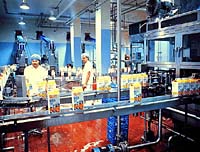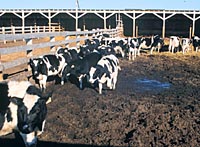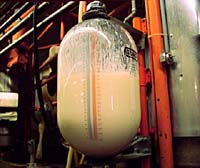|
|

|

|

|
|

The Canadian Dairy Industry contributes over $3 billion to the economy. This is accomplished by the coordination of 1.8 million dairy cattle in Canada by the Canadian Dairy Commission. Approximately 600 dairy farms are operating in Saskatchewan. The bulk of dairy production in Canada is centered in the heavily populated provinces, British Columbia, Ontario and Quebec. The close proximity to retail markets aids in reducing the expense of shipping large quantities of milk.
|

Canada's dairy farms are getting larger in size, but fewer in number. Currently, the average herd size in Saskatchewan is 48 head of milking cows. This trend is a result of the increased efficiency of larger commercial dairy operations. Many dairy farms were established as family farms. Family members provided capital and labour to maintain the continuously operating dairy. Today, many farms are still operated by families but they often require additional labour.
|

The technological advances made in the past 100 years have greatly helped the expanse of the dairy industry. The introduction of mechanical milk processing equipment, refrigeration, and pasteurization techniques aided in the improved quality and preservation of milk and diary products. The development of the milking machine in the 1920s greatly improved the efficiency of milking. By reducing the labour requirement for milking dairy farms were able to increase in size. With the development of the personal computer, dairy farms have been able to keep better and more accurate records of milk production, and expenses. Computers are used to formulate complex diets to meet nutritional requirements at the lowest possible cost. Computers can even be used to coordinate feeding, and robotics developments in the future may aid in the automation of milking.
|
|
|
|
|
